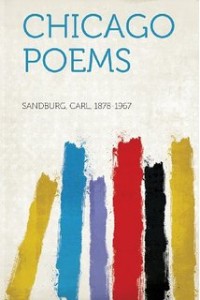Blog
Sandburg’s Nocturne in a Deserted Brickyard
 October of this year marks the hundredth anniversary of the printing of Carl Sandburg’s collection Chicago Poems and ACM is working with mezzo-soprano Julia Bentley and five composers, myself included, to set several of the poems for voice and piano trio for a performance at the Chicago Cultural Center as part of the Ear Taxi festival.
October of this year marks the hundredth anniversary of the printing of Carl Sandburg’s collection Chicago Poems and ACM is working with mezzo-soprano Julia Bentley and five composers, myself included, to set several of the poems for voice and piano trio for a performance at the Chicago Cultural Center as part of the Ear Taxi festival.
I hadn’t read the poems in some time and have greatly enjoyed reading through them again. Many of the poems are quite clear in their meaning and employ a workmanlike, rough-hewn structure. And others leave you thinking about them long after multiple readings. Such a poem is the poem I chose to set for this project: Nocturne in a Deserted Brickyard.
Before writing a note of music I tried to analyze the poem as best as I could. Here is Sandburg’s beautiful short poem and my analysis is below.
NOCTURNE IN A DESERTED BRICKYARD
STUFF of the moon
Runs on the lapping sand
Out to the longest shadows.
Under the curving willows,
And round the creep of the wave line,
Fluxions of yellow and dusk on the waters
Make a wide dreaming pansy of an old pond in the night.
Why stuff of the moon? Not light of the moon? Or some poetic word for light? It’s as if he’s saying that the moon’s contribution to the scene is somehow more than merely light. Stuff of the moon. The moon is investing in the scene, the stuff of the moon like the stuff of life, or the stuff of legend. It’s moonstuff, not light. All things attributed to moon: light, energy, femininity, etc. He’s setting the stage with an odd word but there is power here too.
Runs on the lapping sands. The sands don’t lap of course, the water laps the sand or so we would think. But because of the stuff of the moon perhaps it is confused what is lapping what. Also, perhaps it’s not a bright moonlit night, again stuff does not necessarily evoke light, but could also be the moon’s power to obscure or to subtly alter our perception of a scene.
Out to the longest shadows. The stuff of the moon runs on the lapping sands out to the longest shadows. What an odd sentence. Now we have the “stuff” of the moon running presumably at a tilt from above on the lapping sands. The sands seem to be moving, to be lapping, which is an effect of the moonlight. So the stuff is the moonlight. But again I feel there is more to it.
The stuff of the moon runs on the lapping sands but it stops at the longest shadows. The stuff of the moon cannot penetrate the longest shadows. Or does it create the shadows? Doesn’t moonlight create shadows?
Under the curving willows and round the creep of the wave line, fluxions of yellow and dusk on the waters make a wide dreaming pansy of an old pond in the night.
I believe we’re following the moonlight-created shadows first and then we go round the creep of the wave line which is confusing because the pond would presumably be still. Is he talking about waves of light? Did they know back then that light was waves and particles? At any rate, we follow the moonlight, the stuff of the moon carrying with it its power to alter perception, to the sands and out to the shadows, or defining the longest shadows as we light up everything else, and then under the willows, round the creep of the wave line. Here I think it’s just poetic language evoking waves, of light, of water, etc. Fluxions is a mathematical science-y term. It appears that mister Sandburg knew his physics a bit.
Yellow and dusk flux together the way waves do in particle physics and they make the old pond appear to be a pansy, a kind of flower.
Overall it’s an evocation of a lonely scene. There are no humans here, including I believe the narrator who is not a witness. This poem is an evocation of a scene without a first person narrator. And yet, that can’t be true because reality is altered by the stuff of the moon, or by the waves, fluxions, etc. But perhaps this is the tree that falls in the forest.
At any rate for coherence’s sake let’s go with the idea of this as an evocation of a lonely, nighttime scene. There is wonder here, mystical but also a new mystical, the mystics of modern science and physics in which nothing is as it seems.
Also this is a brickyard but a deserted brickyard. Is it deserted because it’s late at night or is it no longer in use? Is the brickyard itself a metaphor for loneliness, for lost purpose?
At one time the brickyard was a bustling scene, provided jobs and was emblematic of the rise of a great city. now, in its desertion, either temporary or otherwise, there is a sense of loss, of nature reasserting itself without humanity. Chicago is a great city and the work of ambitious men and Sandburg aims to praise that but, he also sees that it is temporary, without purpose aside from that which we humans give it and the works of man appear odd, shiftless
I believe the title is significant too. It’s a nocturne in a deserted brickyard. Not nocturne for or of a brickyard. There’s something to that. This isn’t a song for the brickyard or even a song of the brickyard. It’s a song in the brickyard like the waves represent not only light but sound as well. The path the moonstuff takes creates the shadows, alters the pond and is a kind of ghostly song of loneliness.
- Written by: Seth Boustead
- On: June 24, 2016
News
-
Two New Scores on this Year’s ‘Sound of Silent Film Festival’
I have two new scores on this year’s Sound of Silent Film Festival! The pieces are scored for flute, clarinet, Read More
-
Seth and Gene’s Excellent Electro-Acoustic Adventure Begins at Westbeth March 8
I’m going on tour with my friend Gene Pritsker and it all starts this Saturday night at the famous Westbeth Read More
-
‘Devil’s Food Cake’ Performance in Holland Michigan
We’re taking the Sound of Silent Film Festival on the road to Holland, Michigan where we’re presenting it with Hope Read More
-
New Piece for Viola and Percussion Premiered on January 24
My new work Hurry Up and Wait will be premiered at a Composers Concordance concert of music for viola and Read More
Blog Archives
- July 2022
- June 2022
- April 2022
- March 2022
- January 2022
- October 2021
- September 2021
- August 2021
- February 2021
- November 2020
- October 2020
- June 2020
- April 2020
- January 2020
- December 2019
- November 2019
- October 2019
- September 2019
- July 2019
- June 2019
- May 2019
- April 2019
- March 2019
- January 2019
- December 2018
- November 2018
- October 2018
- September 2018
- August 2018
- July 2018
- May 2018
- April 2018
- March 2018
- February 2018
- January 2018
- December 2017
- November 2017
- October 2017
- September 2017
- August 2017
- July 2017
- June 2017
- May 2017
- April 2017
- March 2017
- February 2017
- January 2017
- December 2016
- November 2016
- October 2016
- September 2016
- July 2016
- June 2016
- May 2016
- April 2016
- March 2016
- February 2016
- January 2016
- December 2015
- November 2015
- October 2015
- September 2015
- August 2015
- July 2015
- June 2015
- May 2015
- April 2015
- March 2015
- February 2015
- January 2015
- December 2014
- November 2014
- October 2014
- September 2014
- August 2014
- July 2014
- June 2014
- May 2014
- April 2014
- March 2014
- February 2014
- January 2014
- December 2013
- November 2013
- October 2013
- September 2013
- August 2013
- March 2011
- August 2010
- May 2010
- October 2009



Leave a Reply